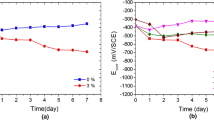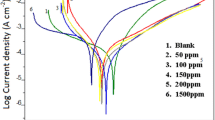Abstract
This study investigated the performance of potassium dichromate and potassium chromate inhibitors on the corrosion of steel rebar in concrete partially immersed in sulfuric acid and sodium chloride medium. The open circuit potential corrosion monitoring technique was employed for the acidic and marine simulating environments, and potential readings were taken in accordance with ASTM C 876. Inhibiting quality and uniformity of the inhibitors were then analyzed using an extreme value statistical modeling approach of the Weibull probability density distribution for determining the most efficient inhibitor. In the inhibitor concentrations used, the statistically analyzed experimental results identified 0.145 M potassium chromate as exhibiting the best inhibiting quality in sulfuric acid whereas the synergetic admixture of 0.032 M potassium dichromate and 0.097 M potassium chromate was predicted as showing the lowest probability of corrosion risk in sodium chloride solution. However, the overall probabilistic results rated potassium chromate as the best inhibitor compared to potassium dichromate in most of the other concentrations investigated in the study, especially in concrete structures exposed to saline environments.









Similar content being viewed by others
References
Franciskovic, J., Miksic, B., Rogan, I., Tomcic M.: Protection and repair of reinforced concrete structures by means of mci-inhibitors and corrosion protective materials. In: Proceedings on Structural Engineering Conferences: International Conferences on Bridges, p. 554 (2006). Available on the web: http://www.cortecvci.com/Publications/Papers/057%20Protection%20and%20repair%20of%20reinforced%20concrete.pdf. Accessed 26 March 2010
Yongmo, X., Hailong, S., Miksic, B.A.: Comparison of inhibitors MCI and NaNO2 in carbonation-induced corrosion. Mater. Perform. 43, 42–46 (2004)
Loto, C.A.: Effect of inhibitors and admixed chloride on electrochemical corrosion behavior of mild steel reinforcement in concrete in seawater. NACE Corros. Prev. Control 48(9), 759–763 (1992)
Berke, N.S.: Corrosion Inhibitors in Concrete. Corrosion 89. Paper 445, NACE, Houston, Texas, pp. 1–10 (1989)
Griffin, D.F.: Corrosion of Metals in Concrete, p. 65. American Concrete Institute, Detroit, MI (1975)
Loto, C.A., Odumbo, E.T.: Electrochemical potential monitoring of corrosion and coating protection of mild steel reinforcement in concrete. Corrosion 45(7), 535 (1989)
Afolabi, A.S.: Synergistic Inhibition of Potassium Chromate and Sodium Nitrite on Mild Steel in Chloride Sulphide Media (2008). Available on the web: http://lejpt.academicdirect.org/A1/143_154.htm. Accessed 18 July 2008
Craig, R.J., Wood, L.E.: Effectiveness of corrosion inhibitors and their influence on the physical properties of Portland cement mortars. Highways Rese. Rec. 328, 77–78 (1970)
Treadaway, K.W.J., Russel, A.D.: The inhibition of the corrosion of steel in concrete. Highways Public Works 36, 40 (1968)
Loto, C.A., Okusanya, A.: The influence of clay addition on the electrochemical corrosion behavior of mild steel in concrete. Corros. Prev. Control J. 36(4), 105 (1989)
Haynie, F.H.: Statistical treatment of data, data interpretation, and reliability. In: Baboian, R. (ed.) Corrosion Tests and Standards—Application and Interpretation, 2nd edn, pp. 83–88. ASTM International, West Conshohocken, PA (2005)
Montgomery, D.C., Runger, G.C.: Applied Statistics and Probability for Engineers, 3rd edn. John Wiley & Sons, Inc. (2003)
Burubai, W., Dagogo, G.: Comparative Study of Inhibitors on the Corrosion of Mild Steel Reinforcement in Concrete, Agricultural Engineering International: The CIGR Ejorunal. Manuscript BC 06 008, vol. IX (2007)
Izquierdo, D., Alonso, C., Andrade, C., Castellote, M.: Potentiostatic determinations of chloride threshold values for rebar depassivation: Experimental and statistical study. Electrochim. Acta 49, 2731–2739 (2004)
Roberge, P.R.: Statistical interpretation of corrosion test results. In: Corrosion: Fundamentals, Testing, and Protection, ASM Handbook, vol. 13A, pp. 425–429. ASM International (2003)
Roberge, P.R.: Handbook of Corrosion Engineering. McGraw-Hill Companies, Inc. (2000)
Polyanin, A.D., Manzhirov, A.V.: Handbook of Mathematics for Engineers and Scientists. Chapman & Hall/CRC, Boca Raton (2007)
Song, T.T.: Fundamentals of Probability and Statistics for Engineers. John Wiley & Sons Ltd, England (2004)
Hausmann, D., Hausmann Consulting, D.A.: Long-Term Performance of Steel in Concrete Immersed in Sea Water, NACE International, Corrosion 0428, p. 1 (2004)
Author information
Authors and Affiliations
Corresponding author
Rights and permissions
About this article
Cite this article
Omotosho, O.A., Okeniyi, J.O. & Ajayi, O.O. Performance Evaluation of Potassium Dichromate and Potassium Chromate Inhibitors on Concrete Steel Rebar Corrosion. J Fail. Anal. and Preven. 10, 408–415 (2010). https://doi.org/10.1007/s11668-010-9375-2
Received:
Revised:
Published:
Issue Date:
DOI: https://doi.org/10.1007/s11668-010-9375-2




